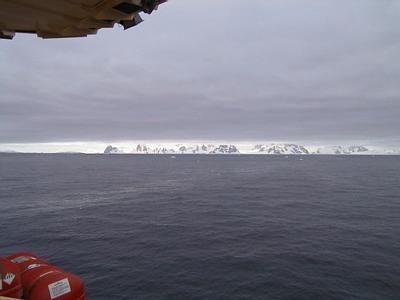27 March, 2000
Actual Bare Rock!
65 04 s, 65 45 w
Just east of Hugo Island and Phelps Rock, Antarctic Peninsula
65 kilometers (40 miles) SW of Cape Monaco, Anvers Island
Winds W @ 8 knots (9mph), Temp 1 C (30 F), Barometer 1012 rising for past
24 hours
Depth 199 m (653 ft)
Ship heading 064 @ 14.4 knots (17 mph)
11:00 AM local and Eastern Standard Time
Sky stratus 0.6 covered
We're coming up into the banana belt of Antarctica now, the
Antarctic Peninsula. With the blue sky, moderate temperatures and gentle
winds, it seems a world apart from the cold and ice of the Amundsen Sea. In
about two hours we should arrive at Palmer Station. We see an occasional
berg, but they are few and far between
Close on our left, perhaps 2 km away, lie Hugo Island and Phelps
Rock. They are not exactly inviting places; nothing visible grows there,
and there are no long sunny white beaches. The islands are a feast for the
eyes though, because about a quarter of Hugo Island is actually exposed,
flat rock. And Phelps Rock has no ice cap at all. Actual bare rock!
Incidentally Hugo Island was named after novelist and poet Victor Hugo, by
the French Antarctic Expedition of 1903-1905. The expedition was led by one
Dr. J.B. Charcot, whose first wife Jeanne was a granddaughter of Hugo. I've
read Charcot's journals (or an account of his explorations-I can't
remember,) and recommend them to anyone interested in polar exploration.
The ship is moving gently in one meter seas. The weather is so
nice I'd like to get a kayak out and go explore around the islands. Well,
maybe not. A second look through the binoculars shows some pretty nasty
looking breaking seas surrounding them.
On the right, perhaps 20 kilometers (12.4 miles) away, are the
serious mountains, glaciers and cliffs of the Antarctic Peninsula itself.
Most of their tops are hidden in the clouds, but occasionally I get a
glimpse of a domed white or jagged black peak between the cloud layers. In
one binocular field are three large glaciers, one of which looks like it is
covered with animal tracks. But then I think about the distance and realize
that what I'm seeing must be crevasses big enough to lose the proverbial
trailer truck into, if you could figure out how to get a trailer truck
there in the first place. The other two glaciers are wider, smoother, and
more gently sloping.
In the patches of sunlight, the peninsula looks inviting. It would
be nice to spend a month or so with a Zodiac, hiking and camping and
following the shore along. The trouble is that this is probably an
exceptionally nice day. I couldn't expect a month of sunny days with light
winds. This, after all, is still Antarctica.
There are lots of birds near the ship. I've been bird watching as
much as I can find time for lately, and have definitely identified one kind
as some kind of albatross, fulmar, prion or petrel, or perhaps a
shearwater, and you can quote me on that. I've tried to take pictures of
the pretty little Cape Pigeons, prominently marked black and white birds
that follow us wherever we go. In twenty pictures I only had three with
recognizable birds in them. In the process of taking all those pictures,
I've seriously strained the last good camera battery. I don't think my
talents lie in ornithology or photography, but I love to watch birds.
Actually, I have gotten to the point where I can recognize birds
as one parcticular kind, but can't relate what I see in the bird book to
what I see in the air. If you look at things carefully enough for a long
enough time, you see patterns and similarities which are not at first
apparent. Perhaps if I spent more time looking at birds, and less staring
at bird books and computer screens, I'd be better at it.
I'm going back out on deck now, to watch birds and mountains, and
get away from this computer screen. I want to watch our approach into Palmer.

A bit of vanity! Peter I (background) and myself (foreground.)

The Antarctic Peninsula south of Palmer Station, as seen from Hugo Island area.

The greater metropolitan Palmer Station area.
Contact the TEA in the field at
.
If you cannot connect through your browser, copy the
TEA's e-mail address in the "To:" line of
your favorite e-mail package.
|
